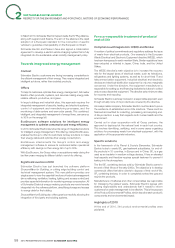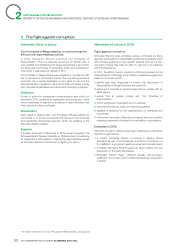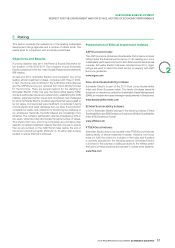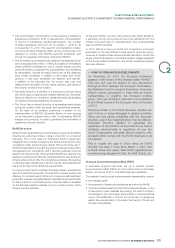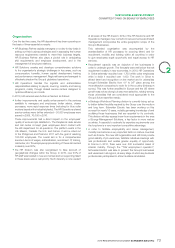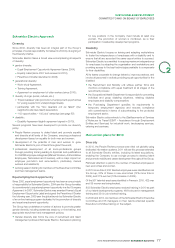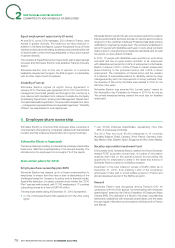APC 2010 Annual Report Download - page 70
Download and view the complete annual report
Please find page 70 of the 2010 APC annual report below. You can navigate through the pages in the report by either clicking on the pages listed below, or by using the keyword search tool below to find specific information within the annual report.
SUSTAINABLE DEVELOPMENT
2SCHNEIDER ELECTRIC’S COMMITMENT TOENVIRONMENTAL PERFORMANCE
4 Eco-Design
Schneider Electric products are mostly made of plastics (such as
thermosetting plastics) and metals (such as copper) bought on the
world’s markets. Their manufacture however does require the use of
components and substances considered by some to be damaging
to health and the environment, such as phthalates or brominates
fl ame retardants. Their use consumes little energy in comparison
with the motors and fi nal applications they operate in. Most of the
products are dumped at the end of their lives. However, certain
products or by-products (such as batteries or the medium voltage
SF6 circuit breakers) which are more dangerous for the environment,
require particular treatment. The life of the products is very variable
depending on their use.
Schneider Electric is subject to European environmental regulation,
with particular emphasis on the use of toxic substances:
•most of the Group’s offer is subject to the REACH directive,
which requires the traceability of dangerous substances;
•about 1% of Schneider Electric’s offer is subject to the RoHS
directive, which requires the elimination of six dangerous
substances : lead, mercury, cadmium, hexavalent chromium,
polybrominated biphenyls (PBBs) and polybrominated diphenyl
ethers (PBDEs).
Schneider Electric is very marginally subject to the WEEE waste
directive and the EuP directive on the energy consumption of
products.
An important point: Schneider Electric applies these European rules
on a world scale.
In addition, the Group’s customers are increasingly asking for
environmental information on the products they buy from us.
Schneider Electric’s Approach In order to meet
these expectations, Schneider Electric has set
out to
•provide its customers with environmental information;
•control the use of dangerous substances;
•bring a high level of innovation to its products.
With this in mind the Group has set up the following programs:
•to respond to regulation: a traceability program for the substances
listed by the REACH directive contained in all its products and
a program to eliminate the six substances listed by the RoHS
directive above the set levels, for all of the Group’s offer;
•to meet the expectations of its customers: a environmental
information program on most of its offer via product environmental
profi les (PEPs) and end-of-life guides;
•Schneider Electric has created the Green Premium label to
communicate this information to its clients. Within the framework
of the Planet & Society Barometer, Schneider Electric has set
itself the target of generating two thirds of its turnover from
GreenPremium products by the end of 2011.
Green Premium products provide its customers with environmental
product profi les: environmental impacts throughout the lifecycle
(energy consumption, carbon footprint, consumption of raw
materials, pollution to the air, water and ground etc.), the identifi cation
and elimination of potentially harmful substances and the conditions
for their recycling, and their manufacture in environmentally friendly
sites.
Main Plans of Action in2010
A Green Premium product has four major characteristics:
•REACH information put online;
•the absence of dangerous substances according to the
prescriptions of the RoHS directive;
•the publication of the product’s environmental profi le, particularly
useful in determining its carbon footprint;
•the publication of an end-of-life instruction form if necessary.
REACH directive
The European REACH regulation compliance program, started in
2008, aims to:
•ensure that substances used by Schneider Electric and its
subsidiaries are registered and authorised for the applications in
question, in accordance with REACH requirements;
•formalise the information to be provided to customers about the
presence of hazardous substances;
•take account of the information to be supplied under the REACH
directive and the technical constraints of the RoHS directive in
the process of developing new products;
•anticipate the substitutes that will certainly be needed for certain
chemical substances, avoiding any impact on Schneider Electric
product performance.
This program was strengthened in 2010:
•to anticipate the deadline of December 1, 2010, Schneider
Electric launched a program to verify that its suppliers have
registered substances used in applications with the European
Chemicals Agency, in accordance with the demands of the
REACH regulation. The substances concerned are those which
are consumed in or imported into Europe at the rate of over 1,000
tons per year, and all category1 and2 reprotoxic, carcinogenic,
mutagenic substances consumed in or imported into Europe at
the rate of over one ton per year, as well as R50/53 substances
which are very toxic for aquatic organisms, and consumed in
or imported into Europe at the rate of over 100 tons per year.
This verifi cation is accompanied by the updating, on Schneider
Electric production sites, of the procedures for using chemical
substances, as shown on the new safety data forms of Schneider
Electric suppliers.
2010 REGISTRATION DOCUMENT SCHNEIDER ELECTRIC68


